|
| OO Scale | N Scale | G Scale | Z Scale | HO Scale | Slot Cars & R⁄C |
| |||||||
|
|||||||
| Home Page | |||||||
| BUY GIFT VOUCHERS | |||||||
| Products | |||||||
| Latest News | |||||||
| RIGHT LINES | |||||||
| Bargains | |||||||
| Downloads | |||||||
| Events | |||||||
| Careers & Jobs | |||||||
| Carriage Services | |||||||
| About Us | |||||||
| Contact Us | |||||||
| Pay Us A Visit | |||||||
| Meet The Staff | |||||||
| Links | |||||||
| SHOPPING BASKET |
Your shopping basket is empty. To add an item, click the "Buy" button
| YOUR ACCOUNT | ||
|
||||
 |
||||
| Prodigy Advance Digital System |
||||
| Cased Controllers |
||||
| Panel Mount Controllers |
||||
| Walkabout Controllers |
||||
| Modules & Transformers |
||||
| Scenics & Accessories |
||||
| Wiring & Electrical Components |
||||
| Tiny Signs | ||||
| Tools | ||||
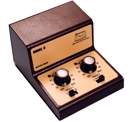 |
||||
| RECENTLY VIEWED |
| GM2210201 - Class 73 E6003 BR Green | ||
| ODNFT034 - Ford Transit MkV Van Parcelforce | ||
| N12800 - On the Platform Sound Scene | ||
| N07343 - Dark Green Structure Foam 5mm (15g) | ||
| GF42-146 - Scenecraft Highley Station Yard Crane (Pre-Built) | ||
| More ›› |
| O Scale | Wargaming | Architectural | Narrow Gauge | Tools+ | ||
Railway Architecture Part 2 - Mock Tudor

STUART JORDAN looks at the use of this distinctive architectural style.
Tudor Revival/Mock Tudor is an architectural style that became popular in the UK in the mid to late 19th Century. As its name suggests, it takes influences from rustic styles used in the Tudor period (1485-1603), which include half-timbered frontages, steep roofs, and tall, narrow features like chimneys and mullioned (partitioned) windows.
the style originally developed as part of the Arts and Crafts movement, which rejected modern industrialisation and looked to the past for inspiration with this in mind, the use of the style on the railways is somewhat ironic.
One example of a direct influence of Tudor styles on a railway station is on the fringe of East Anglia. The station at Stamford, Lincolnshire was built by an engineer named Sancton Wood in 1846, for the Midland Railway.
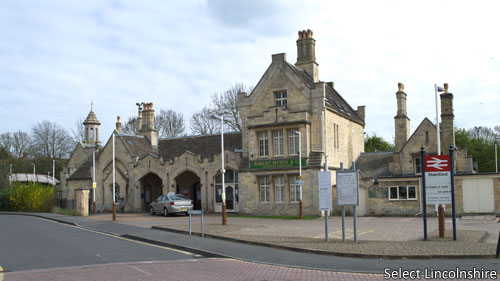
Stamford Station
The design of the station was inspired by nearby Burghley House, which was itself inspired by Richmond Palace. Burghley House was completed in 1587 for Sir William Cecil (1st Baron Burghley), Lord High Chancellor to Elizabeth I.
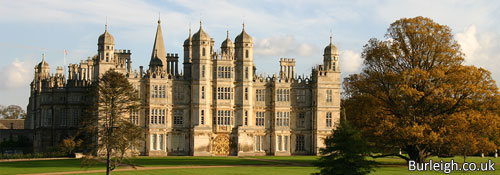
Burleigh House - note the turrets, which were echoed in the design of Stamford.
Sancton Wood took the turrets and tall windows from Burghley, and added them to his station. Later, Wood designed the termini of the Ipswich & Bury Railway Ipswich in an Italianate style, and Bury St Edmunds in Baroque.
Working around the same time in Northern Ireland was Berkeley Deane Wise, the Chief Engineer of the Belfast & Northern Counties Railway. Antrim Station (1848) and Carrickfergus (1862) were both built by him in Mock Tudor style, but his most famous use of this style is the station at the seaside town of Portrush.
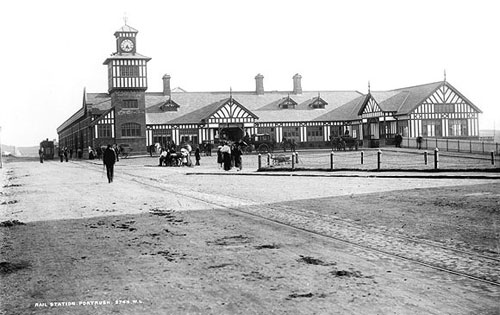
Portrush Station
Although the station opened in 1855, it was extensively rebuilt by Wise in 1893 to accommodate the increase in holiday traffic. Mock Tudor features include half-timbering, gabled ends, tall chimneys, and dormers in the roof. At the eastern end of the main station building is a brick clock tower with a half-timbered top.
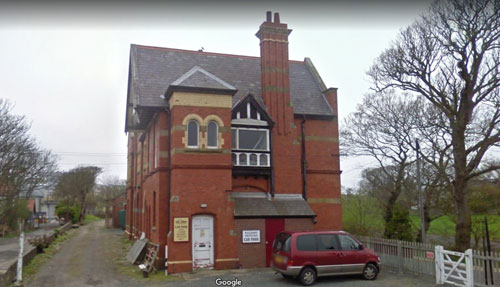
Port St Mary Station
Port St Mary station on the Isle of Man was another station that was expanded due to an increase in holiday traffic. This station on the Isle of Man narrow gauge railway was built by James Cowle in 1898. Although a mixture of different architectural styles, Port St Mary Station is predominantly Mock Tudor.
Its rare to be able to write anything about railway architecture without mentioning Isambard Kingdom Brunel. Brunel used the style when designing stations like Culham in Oxfordshire, which opened in 1844, with characteristic high chimneys.
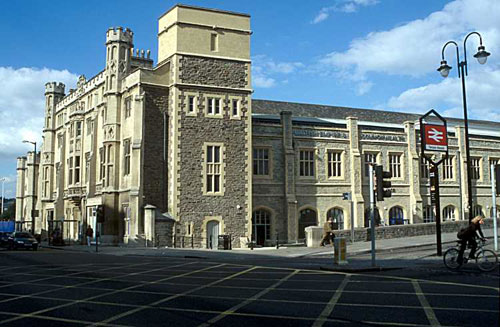
The original station building at Bristol Temple Meads.
Brunel used the style on what would be one of his greatest stations. In 1840 the original Bristol Temple Meads station opened, with services to Bath. A connection to London Paddington was made the next year with the opening of the Box Tunnel, as well as the opening of the Bristol & Exeter Railway. Temple Meads grew in size and importance, and was extensively expanded in 1870 However the original Mock Tudor structure still stands to this day.
Modelling Mock Tudor
There quite a few building kits on the market which will allow you to add a dash of Mock Tudor to your layout. Take a look at some of the continental ranges like Faller or Vollmer, as although some of their kits are prototypically Germanic, there are quite a few half-timbered buildings that can be used out of the box or after modification.
See below for some examples from our ranges:
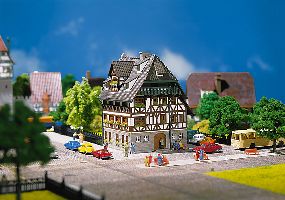
Faller N Scale FA232280 Tudor Half Timber House Era I
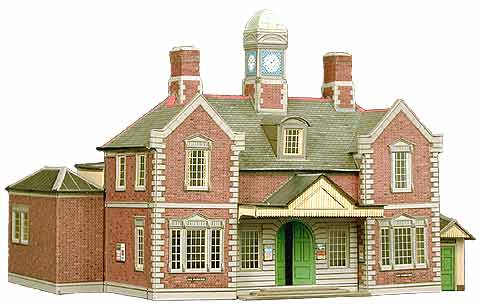
Superquick OO Scale SQA10 Terminus or Through Station
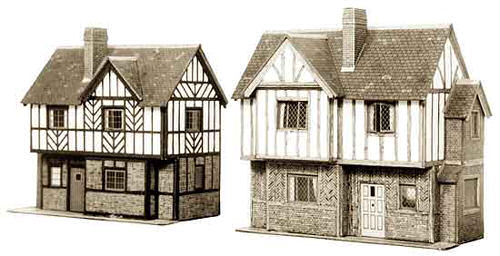
Superquick OO Scale SQB28 Two Elizabethan Cottages - Card Kit
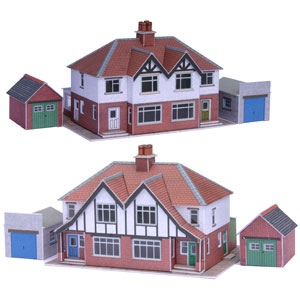
Metcalfe N Scale MEPN166 Semi Detached Houses
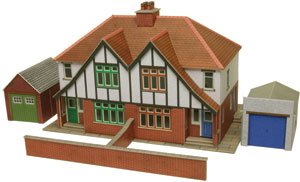
Metcalfe OO Scale MEPO266 Semi Detached Houses
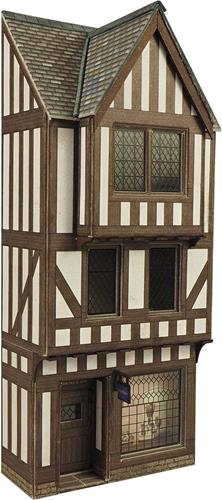
Metcalfe OO Scale MEPO421 Low Relief Half Timbered Shop Front
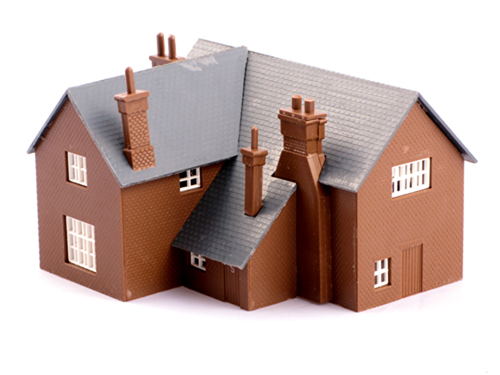
Kestrel N Scale GMKD37 Farm House
|
We are always looking to make improvements to our website to try and improve the quality of your visit. We would welcome your feedback and suggestions, so please do not hesitate to e-mail our webmaster with your comments. Alternatively call us on 01903 884488.
Home Cookies Privacy Statement Terms & Conditions Site Map Site Guide
WEEE Regulations Glossary Careers & Jobs
Tel – +44 (0) 1903 884488 Fax – +44 (0) 1903 884377 E-Mail us – click here
Gaugemaster.com is a trading name of Gaugemaster Controls Ltd.
Registered in England No. 2714470, Registered office:
Gaugemaster House, Ford Road
Arundel, West Sussex, BN18 0BN, United Kingdom
VAT Reg. No. 587 8089 71
Copyright © 2003-2014 Gaugemaster Controls Ltd. All Rights Reserved.
















